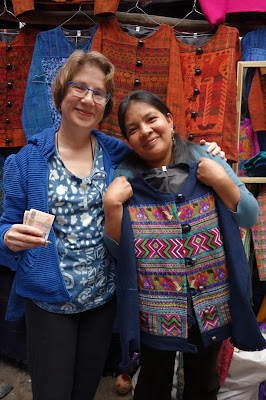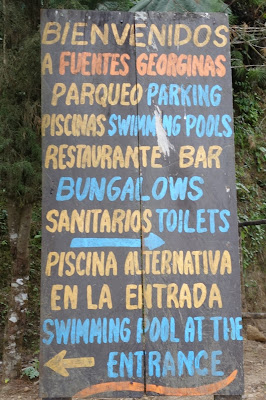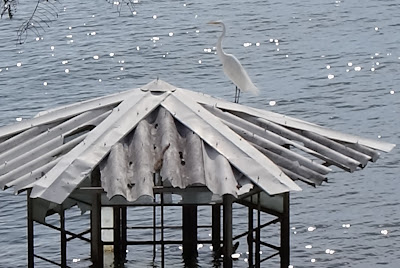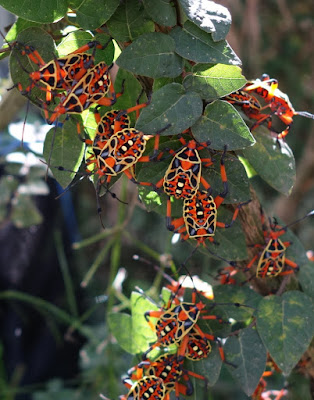farm near that ancient capital, the latter two of which are described in my first blog about this trip,
shopping at the bustling Sunday market at Chichicastenango, bathing in a refreshing hot springs and hiking in the surrounding natural area, and visiting a coffee plantation.
There are 29 volcanoes in Guatemala, many of which are still considered active. The major ones are located in the south central and southwest part of the country. You can see the list by clicking on the blue underlined words at the start of this paragraph.
The 930-mile-long Central American Volcanic Arc (CAVA) extends along the Pacific coast from Guatemala through El Salvador, Honduras, Nicaragua, and Costa Rica and ends in Northern Panama. It is along the western edge of the Caribbean oceanic tectonic plate.
I saw my first view of the mountains (volcano?) through clouds from the air as I flew into Guatemala City.
Antigua, where I stayed for the first three nights of my trip, is surrounded by three large volcanoes: Volcan de Fuego, Volcan Acatenango, and Volcan de Agua or Hunapú. Acatenango last erupted in 1972 and Fuego is constantly active.
 |
| A photo I took our last day in Antigua |
 |
Click on this link to find a nice YouTube Presentation or this one to get a better view of the people. Luckily it was not raining the day we were there. However, there were a lot fewer people than normal. Tourism is down, in part because of the Zika fear, which has not affected this part of the country.
As we drove along on the two-lane road, we passed through small town and saw fruit stands along the way. We stopped at one and bought fruit that we could peel including the chirimoya in the back center left and granadillo (passion fruit--delicious!).
Someone had gotten a local newspaper, and in addition to an interesting article on the number of people in Guatemala speaking native languages, I also saw Zits in Spanish.
When we entered town, we saw people unloading their vehicles to set up their merchandise for sale.
Almost all have booths from which they sell, but a few sell from the street.
The Church of Santo Tomas was our gathering point. I was fascinated to learn that it was built in 1545 on a Pre-Colombian Mayan temple platform and is still used by Mayan priests for rituals.
 |
| Musicians playing on the top steps of the entry to the church |
 |
| So gorgeous that I had to touch them to be sure they were real! |
We had been warned not to take backpacks nor carry purses carelessly because of professional thieves. Only one person took a backpack but she wore it in front, and most of us left our cameras behind, carefully hid our smart phones, and stored our money carefully. I only took pictures of places where we bought items.
 |
| I bought very pretty placemats here. |
 |
| A very pretty tablecloth this family made |
At least five of us stopped at a place where beautiful jackets were sold. We got a good price as at least 8 were purchased. Here is the one Betsy got.
I had not planned to get one, but the colors on the one below were so attractive that I made the purchase and and I have already worn it twice and will continue to do so when I talk about Guatemala.
Diane and I bought several of these small purses (with straps).
Mindy was looking at skirts and I ended up buying this one. I really like it, but when I took it off after wearing it on a warm day, I found out some of the blue had run on me! So when I got home I soaked it for a good while in salt water.
We met at the church to go to a restaurant for lunch and agreed that we needed another hour to shop after lunch!
Right below the restaurant was the colorful town cemetery. Several of our group walked down the the cemetery.
 |
| Pet birds in the patio |
The vegetarian lunch was delicious! The homemade tortilla chips were a hit with many. Chayote is one of the veggies below.
The photo below gives you a good view of the rows of booths.
We went looking up, down, and around the labyrinth of rows trying to to find a place that had a special item that looked like it would be a colorful matzah holder for Passover.
 |
| A woman selling flowers on the street |
 |
| Women making tortillas and selling them |
 |
| Threads. for sale |
 |
| An unusual bean for sale |
When we got back to our meeting place, two young girls were trying to sell us pencils and bookmarks. Susan talked to one about school. The girl said that she was in 4th grade and was selling at the market as today was Sunday. She assured Susan that she was staying in school, so then I took a picture of the three of them!
I didn't go in but took photos of others and explored the area. There are 7 pools, five in the main area about 1/4 mile from the parking lot and then two below the parking lot.
 |
| Picture from website of top pools and changing area (white) |
 |
| Flowers along the way |
While most of the others enjoyed the hot springs, I headed out to explore the nature walk.
We were told by our guide that some of the plants were so big that they looked prehistoric. What do you think?
 |
| Very large ferns |
 |
| Along the path, downhill |
 |
| huge ferns |
 |
| As we waited for lunch to arrive, Pamela sat by one of the lower pools. |
We walked down to the restaurants and pier area and got this lovely view of Lake Atitlan.
Then we walked out on a rather rickety pier,
toward our boat.
We all got in the boat
and put on our life jackets.
Maya enjoyed the ride!
We arrived at Santiago en Solala. This is the sign for the main pier of the town of Santiago Atitlan in Solala.
Here is the pretty view of the lake looking back as we walked away from the lake.
 |
| A wall painting: Trees give us life. Take care of them! |
 |
| Women washing clothes at the shore of the lake |
 |
| Snake dragon sculpture on edge of the lake |
 |
| Men rowing canoes on lake, often standing Most of us walked to the Posada de Santiago, a very nice inn and restaurant, for lunch. The door is beautiful. Much of the woodwork inside was done by the man who works (translates, etc) with the MW beaders (who make mezuzot). |
The restaurant also had a small gift shop with nice items. It also sold several books by the owner's
mother, Bonnie Dilger.
We also stopped at what Fidencio called the best coffee shop in Guatemala City, El Injerto, to have coffee and buy some. It was very close to Chabad. \
 |
| Beautiful plant along the way |
The last tour we went on was of an eco-tourism coffee processing farm called Los Tarrales. The place also grew coffee but we did not see much of that process. We first had lunch and then divided into two groups, one which went on a hike and the other that went bird watching and then saw the coffee processing plant.
This farm was started 170 years ago by immigrants. The coffee farm has 2,600 acres planted in coffee, from 3500 feet above sea level and up. Some are planted on flat areas and some on hills. Pictures on the walls told of some of the history of the farm. .
Here is the big house or "casona." It started out small with many rooms added over the years.
There are some old German trucks on the property from past owners. The current owners are of French background.
Some of the items on the wall and in the visiting area:
 |
| A picture of a quetzal, the national bird of Guatemala |
As we started our bird walk, we left the house and saw some beautiful color on a plant nearby.
And when our guide had us get closer, we saw these beautiful insects!
In the last ice age, birds came to Central America where they could survive.
Guatemala has more than 400 types of local bird species and 300+ more that migrate to and from the country. Some parts of Guatemala have over 900 species of birds! The southern side of Lake Atitlan has over ten per cent of the world species of birds.
More than 300 bird species have been identified around the Atitlan volcano including the Horned Guan and the Azure-rumped Tanager. When our guide took out a group at 6 a.m., there saw over a dozen different kinds of birds. We were lucky to see about a half dozen. Our guide was very knowledgeable (self-taught). He had a telescope and took pictures by putting our phones/cameras on the eye piece. I did manage to take a few photos myself, including the lineated woodpecker. We saw a black vulture and a green perica (parakeet), Golden fronted woodpecker, black-headed saltator, and a grackle.
Birds often seen in this area include the summer tanager, Kill bill toucan, Arancaru toucan, and the emerald toucan which is the most common.
The national tree of Guatemala is the deciduous Ceiba.
I was surprised to see bromeliads growing on power lines.
Some pretty flowers that we saw.
The farm grows two kinds of coffee seedlings. The first is the Robusta which does not produce good quality coffee but is very resistant to fungus and makes strong, tall plants. The second is Arabica, which has a better taste. The Arabica is grafted onto the Robusta when the plants are about a month an a half old. The people that do the grafting are very good at this delicate work. The young seedlings are below. The Robusta were planted two weeks before the Arabica, so the dirt isn't off the tops of the Arabica yet.
The seeds are planted in warm compost mixed with ordinary soil. It takes a while for the seeds to germinate.
Coffee trees can life up to forty years but they get too tall, so they are useful for a ten to twelve year period. It also takes them three to four years to begin to produce coffee beans. The coffee here is not certified organic but uses "good practices." The coffee is shade grown (so it produces less caffeine) and they use only a small amount of chemicals.
The tour was interesting....a bit long as by then we were getting tired, but not easy to write about in the blog. One fascinating fact--the second and third class coffee beans are used to make instant coffee.
Coffee is the top cash crop of Guatemala. During two to three months of harvesting and processing of the beans, seasonal workers can earn $20 to $25 a day, and families an earn $100 to $150 a day. When one works in a fruit or sugar can harvest, the take home pay per can is half that.
This farm uses the coffee pulp for composting. The pulp is mixed with soil and worms to make the compost.
They use the compost on the farm and also sell it locally. It takes two months for the worms to make the compost.
We had a farewell dinner in Antigua and wished Susan a very happy birthday.
She was given a pinata and serenaded by the staff.
That night we all gathered in Ilana and David's room for final thoughts and goodbyes, the end to a marvelous travel and learning experience.
I plan to return to Guatemala the same time next year and volunteer. And I hope to let others know in the Seattle area about the projects I visited, how to purchase the fair trade religious objects, especially the Jewish ones, and also to tell about the very special Reform Jewish community in Guatemala city.


















































































No comments:
Post a Comment